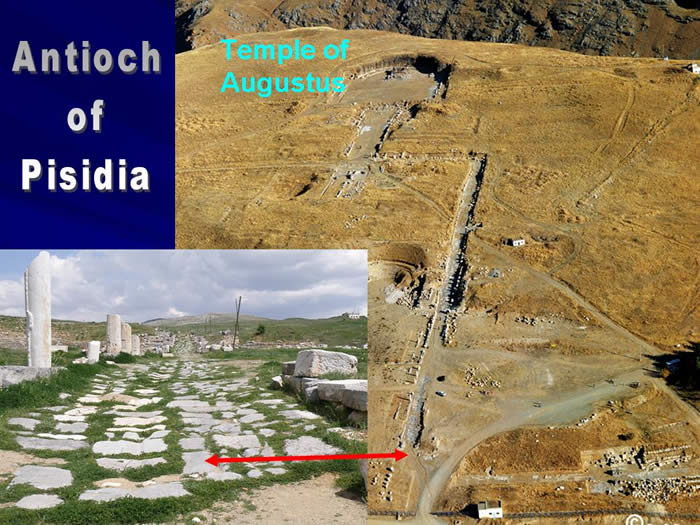
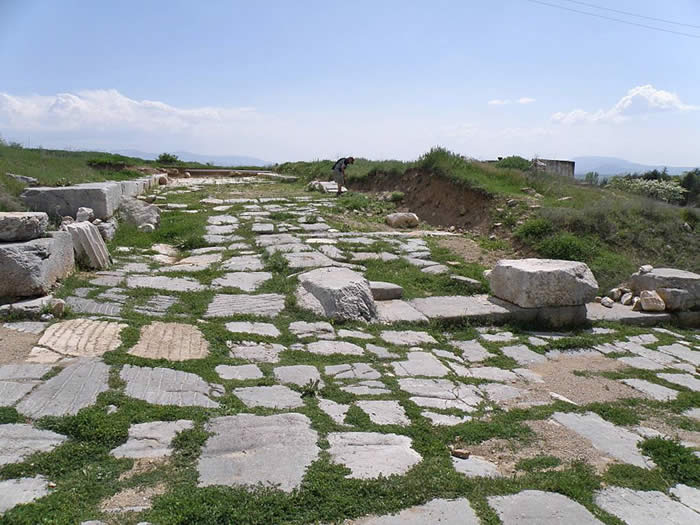
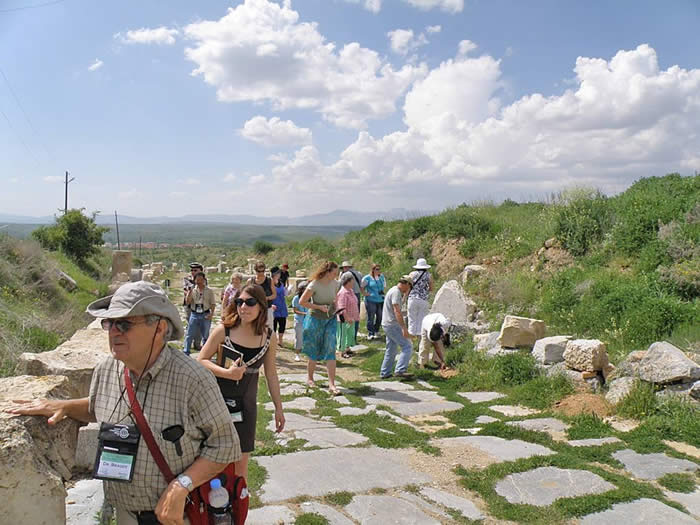
2009 Holy Land Tour – Turkey
Part 4 – Pisidian Antioch
Click on photos and charts for larger version
At the end of class last week, I was about to take you on the first missionary journey of Paul, where he and Barnabas and John Mark, and probably others, traveled.
Before we follow the path they took, let’s visit the city of Pisidian Antioch, to which Paul and Barnabas went directly after leaving the island of Cyprus.
Antioch of Pisidia
Of the sixteen ancient cities in Turkey named Antioch, only two are of any significance to Bible students today. One is Antakya (Antioch of Syria) – sometimes called Antioch on the Orontes (Orontes River). The other is Antioch of Pisidia (or Pisidian Antioch). Both cities played a major part in the early days of the church. Around 49-50 A.D., the apostle Paul visited this city for the first time. And his first recorded sermon was preached there – Acts 13:15-51.
In 25 B.C. the Roman emperor Augustus Caesar made Pisidian Antioch a Roman colony, giving it the title of Colonia Caesarea Antiochia, and placed it under Roman control. As a Roman colony, veterans of the Roman army settled here in their retirement. By the middle of the first century, several members of the imperial household had served as magistrates here.
At the highest point in the city, Augustus had a temple built to himself, although he dedicated it to the mother goddess Cybele (Kybele). The front of the temple had a stairway of twelve steps leading to the porch. An interesting fact is that this building was used as an “open air church” around 400 A.D. At far right is an aerial view of the ruins today – this is an eastern view. The photo is probably a few years old, and doesn’t reflect some additional excavations since then. But you can see that at the highest elevation is the Temple of Augustus. What it doesn’t show is excavations on some of the side streets. The inserted photo is looking up the main east-west street. Next to it is a photo of one side street they have uncovered since my last time here. And the photo on the left is taken at the same spot down the main street.
At far right is a layout of the city as it was in the early years of the church (northern view). Let me show you a couple pictures of the area around the Temple of Augustus. You can tell that the semi-circle building around the temple was two stories high. The holes in the stone wall are where the wood beams under the second story were placed.
Let me show you a 3-dimension rendition of Antioch by the University of Michigan. And you can see the two-story edifice around the temple.
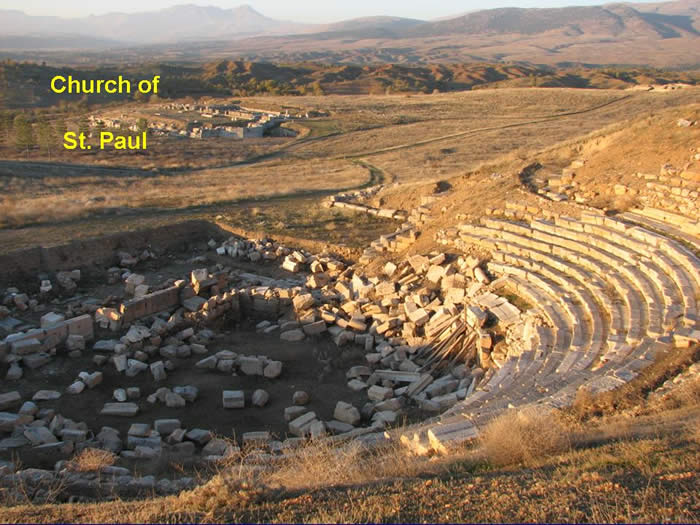 There are ruins to two churches in the city. In this 3-dimension model, you can see the Byzantine basilica just to the left of where the two main streets cross. On the western edge of the city was the 4th century church dedicated to the apostle Paul (not part of the 3-D model). It is considered a large church for that time – one of the largest found in Asia Minor. In the last century they have found another building under this church. It is believed to be the ancient synagogue, possibly the one visited by Paul and Barnabas. They have uncovered a mosaic floor of the building under the church, and it has Psalm 42:4 inscribed on it.
There are ruins to two churches in the city. In this 3-dimension model, you can see the Byzantine basilica just to the left of where the two main streets cross. On the western edge of the city was the 4th century church dedicated to the apostle Paul (not part of the 3-D model). It is considered a large church for that time – one of the largest found in Asia Minor. In the last century they have found another building under this church. It is believed to be the ancient synagogue, possibly the one visited by Paul and Barnabas. They have uncovered a mosaic floor of the building under the church, and it has Psalm 42:4 inscribed on it.
I now want to take you on the first missionary journey of Paul, where he and Barnabas and John Mark, and probably others, traveled.
To introduce us to the setting of the first journey of Paul, let me ask a few questions. As I mentioned a moment ago, we know that Barnabas was Paul’s companion on this trip.
WHAT DO WE KNOW ABOUT BARNABAS PRIOR TO THIS MISSIONARY TRIP?
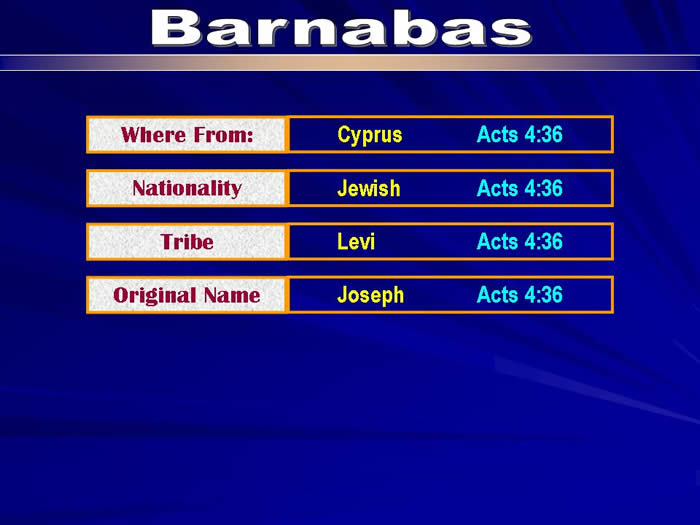
DO WE KNOW WHERE BARNABAS WAS FROM?
He was from Cyprus (Acts 4:36).
WHAT NATIONALITY WAS BARNABAS?
He was a Jew (Acts 4:36).
ARE WE TOLD WHAT JEWISH TRIBE HE WAS FROM?
Yes, he was a Levite Acts 4:36).
WAS BARNABUS HIS REAL (OR ORIGINAL) NAME?
No. He was named Joseph (Acts 4:36).
WHAT ELSE DOES THE BIBLE TELL US ABOUT BARNABAS?
• Barnabas means “son of encouragement.” (Acts 4:36).
• It was Barnabas who introduced Saul to the Jerusalem apostles, when they were apprehensive about meeting him. (Acts 9:27)
• When the apostles in Jerusalem heard about the gospel’s success in Syrian Antioch, not only among the Jews, but also among the gentiles, the leaders in Jerusalem sent Barnabas to provide leadership (Acts 11:22). And when Barnabas appraised the situation, he knew there was only one man who could understand the backgrounds of both Jews and Greeks.
• Barnabas leaves Antioch and, according to Acts 11:25, he “went to Tarsus to look for Saul.”
• Barnabas and Saul met with, and taught, the people for a whole year. The new converts were grounded in the Word of God. And it was here that the followers of Christ were first call “Christians.”
There is one more thing of note about this man Barnabas. Many of the things on our list were given in Acts 4:36. Let me read that verse and add verse 37. Most of us are familiar with the story that begins in verse 1 of Acts 5. It is the story of Ananias and Sapphira and their death because they lied to the Holy Ghost when they sold property and gave part of it to the apostles for the Church. The two verses we are now going to read directly precede that story.
Acts 4:36-37 NIV
36 Joseph, a Levite from Cyprus, whom the apostles called Barnabas (which means Son of Encouragement),
37 sold a field he owned and brought the money and put it at the apostles' feet.
This was a very generous man. He is one of the earliest converts to Christianity.
In Acts 9, we find the conversion of a man named Saul. This Saul had an encounter with Jesus on the road to Damascus, and was blinded, and was led by the hand into Damascus. God laid it on the heart of a man named Ananias to go a prayer for Saul to receive his sight.
The Lord made such a change in Saul’s life, that he immediately began to preach Jesus in the synagogue. He taught about Jesus for some time – although we don’t know how long – in Damascus (9:20-22). Eventually, “after many days,” the Jews sought to kill him, but Saul escapes and leaves the city.
In the next verse, we are told that Saul went to Jerusalem and wanted to meet the apostles, but they were suspicious of him. We don’t know how long after leaving Damascus that he goes to Jerusalem. But we do know it was Barnabas who trusted him, and brought Saul to the apostles. He is with the apostles, in the Jerusalem area, and once again people wanted to kill him because of his testimony of Christ. This time the followers of Christ helped Saul escape to Caesarea Maritima, where it appears he catches a boat to Tarsus (9:30).
We don’t hear of Saul of Tarsus again until chapter 11 of Acts. Because we are talking of only two chapters in Acts where nothing more is mentioned of Saul, we might think that it was a short span of time. But it could well have been 8 to 10 years.
A revival breaks out in Syrian Antioch as recorded in Acts 11:19-21. And this revival was not only among the Jews, but also the Gentiles (Acts 11:20). Two verses later, we are told that the apostles in Jerusalem heard about what was happening, and sent Barnabas to appraise the situation. And when Barnabas appraised the situation, he knew there was only one man who could understand the backgrounds of both Jews and Greeks. Barnabas leaves Antioch and, according to Acts 11:25, he “went to Tarsus to look for Saul.”
After Barnabas finds Saul, they go to Antioch and they taught the people for a whole year. The new converts were grounded in the Word of God. And it was here that the followers of Christ were first call “Christians.”
And now, some 8 to 10 years after Saul’s conversion, Barnabas is still active in the church. And he is so respected by the apostles, they send him to Antioch to appraise what was happening. And he has the wisdom of God to search out the right man for the job. But once Saul arrives in Antioch, Barnabas doesn’t leave him to fend for himself. Together they work for a whole year in Antioch, helping both Jew and gentile to grow.
Acts 11:25-26 NIV
25 Then Barnabas went to Tarsus to look for Saul,
26 and when he found him, he brought him to Antioch. So for a whole year Barnabas and Saul met with the church and taught great numbers of people. The disciples were called Christians first at Antioch.
Near the end of that year, there was a famine in the land, and the congregation in Antioch took it upon themselves to sent relief to the poor believers in Judea. And they send Barnabas and Paul to deliver their gift. You can read that in the last two verses of Acts 11 (vss. 29-30).
I don’t know how long they were in Jerusalem, but the last verse of Acts 12 tells us they fulfilled their ministry of delivering the gift. And as they returned to Antioch from Jerusalem, they have another person with them. His name is John Mark, whose mother (named Mary) lived in Jerusalem. Colossians 4:10 informs us that Mark is a cousin of Barnabas.
We know that by this time, Saul had been a follower of Christ at least 14 years. In Galatians 1, the apostle Paul, who was Saul, speaks of going to Jerusalem the first time. But, in Galatians 2:1, Paul said there were 14 years between his first two visits to Jerusalem.
Galatians 2:1 NIV
2 Fourteen years later [14 years after his first visit to Jerusalem] I went up again to Jerusalem, this time with Barnabas. I took Titus along also.
Most likely this visit is the one where they take the care package from Antioch to Jerusalem.
I don’t know how long they were in Jerusalem, but the last verse of Acts 12 tells us they fulfilled their ministry of delivering the gift. And as they returned to Antioch from Jerusalem, they have another person with them. His name is John Mark, whose mother (named Mary) lived in Jerusalem. Colossians 4:10 informs us that Mark is a cousin of Barnabas.
Paul’s First Missionary Journey
 This brings us to the beginning of Acts 13. In the first verse, we find five men mentioned by name. Let’s read the first two verses.
This brings us to the beginning of Acts 13. In the first verse, we find five men mentioned by name. Let’s read the first two verses.
Acts 13:1-2 NIV
1 In the church at Antioch there were prophets and teachers: Barnabas, Simeon called Niger, Lucius of Cyrene, Manaen (who had been brought up with Herod the tetrarch) and Saul.
2 While they were worshiping the Lord and fasting, the Holy Spirit said, "Set apart for me Barnabas and Saul for the work to which I have called them."
The names of the three men beside Paul and Barnabas and where they are from could be an interesting lesson on its own. But let’s hurry to begin our journey with Paul and Barnabas. It should also be noted that he is called Saul, not Paul, until part way through this trip. As I read, follow with me on the map I will put on the screen.
Acts 13:3-16 NIV
3 So after they had fasted and prayed, they placed their hands on them and sent them off.
4 The two of them, sent on their way by the Holy Spirit, went down to Seleucia and sailed from there to Cyprus.
5 When they arrived at Salamis, they proclaimed the word of God in the Jewish synagogues. John was with them as their helper.
6 They traveled through the whole island until they came to Paphos.
As a point of reference, it is about 80 miles from Salamis to Paphos. But the words used here suggest this trek across the island was not a straight line. The words – They traveled through the whole island – means exactly that. It wasn’t just east to west, but also north and south. Let’s continue reading.
Continuing our reading in Acts 13.
There they met a Jewish sorcerer and false prophet named Bar-Jesus,
7 who was an attendant of the proconsul, Sergius Paulus. The proconsul, an intelligent man, sent for Barnabas and Saul because he wanted to hear the word of God.
8 But Elymas the sorcerer (for that is what his name means) opposed them and tried to turn the proconsul from the faith.
9 Then Saul, who was also called Paul, filled with the Holy Spirit, looked straight at Elymas and said,
10 "You are a child of the devil and an enemy of everything that is right! You are full of all kinds of deceit and trickery. Will you never stop perverting the right ways of the Lord?
11 Now the hand of the Lord is against you. You are going to be blind, and for a time you will be unable to see the light of the sun." Immediately mist and darkness came over him, and he groped about, seeking someone to lead him by the hand.
12 When the proconsul saw what had happened, he believed, for he was amazed at the teaching about the Lord.
13 From Paphos, Paul and his companions sailed to Perga in Pamphylia, where John left them to return to Jerusalem.
14 From Perga they went on to Pisidian Antioch. On the Sabbath they entered the synagogue and sat down.
15 After the reading from the Law and the Prophets, the synagogue rulers sent word to them, saying, "Brothers, if you have a message of encouragement for the people, please speak."
16 Standing up, Paul motioned with his hand and said: "Men of Israel and you Gentiles who worship God, listen to me!
The words in the verses that follow are the first recorded sermon of the apostle Paul. There are a couple of things to note in what we read.
1. Verse 9 is where the narrative of Luke, the writer,where he no longer refers to him as Saul, but as Paul.
2. We are not given the reason, but John Mark decides to return to Jerusalem.
3. The go directly from Cyprus to the city of Perga, which was 8 miles from the Mediterranean Sea. It was, however, located on the Cestrus River, which was navigable as far as Perga. But it doesn’t appear they stayed in Perga, but immediately continued north.
4. The governor, Sergius Paulus became a convert to Christianity after Paul preaches.
This last fact – the governor’s conversion – may have some bearing on why they went directly to Antioch. They travel almost due north about 80 miles to the city of Antioch of Pisidia. And it is indeed a difficult journey through the Taurus Mountains. The Roman Road leading from Perga to Antioch of Pisidia was known as Via Sebaste, or the Sebastian Way, completed by Rome in 6 B.C.
I said that taking a direct root to Antioch may have had something to do with the governor’s conversion. Historical documents exist that give the impression that Sergius Paulus had relatives in Antioch. Of course they would be people of the wealthy class. Some have speculated that Sergius Paulus wanted the apostle Paul to take the gospel message to his relatives.
One further evidence of the governor’s possible connection to this city is found in an inscription found there, now in the museum at Yalvaç. Here is a photo of that stone with the inscription. It refers to someone named Sergius and Paulus. Those were not uncommon names, so we don’t know for sure it was the governor.
When they arrive in Antioch, Paul takes the opportunity to preach Christ in the synagogue in Antioch. Because of the success of that message, many people wanted to hear more. But some of the Jews of this city stirred up opposition to Paul and they were expelled out of the city.
They travel about 80 miles southeast to the city of Iconium – today called Konya. This brings us to the beginning of Acts 14. Iconium was the capital city of the region of Lycaonia. They preached the gospel again in the synagogue, and again, the Jews there stir up the people so they plan to stone them. Paul and Barnabas leave Iconium and go to the cities of Lystra, also in the province of Lycaonia. At Lystra, Paul prays for a man who had crippled feet from his birth. The man is healed and he leaps and walks. That is recorded in Acts 14:8-10. But the Jews came from Antioch and Iconium to Lystra and once again stirred up the people. This time they succeed in stoning Paul, leaving him for dead. But the Lord raises him up, and the next day they go to Derbe (Acts 14:20).
After preaching the gospel in Derbe, they retrace their steps. They go back through each city where they had recently been persecuted, appointing elders in each of the churches in those cities.
The return south on the Via Sebaste to the city of Perga. In Acts 14:25, we are told on this occasion, Paul does preach the gospel at Perga. The same verse also say they went to the city of Attalia – modern day Antalya.
From Attalia, they set sail for Antioch of Syria. And today, the modern yacht harbor (at right) is the location of the ancient harbor from which Paul and Barnabas sailed.